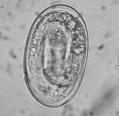Difference between revisions of "Dictyocaulus arnfieldi"
Jump to navigation
Jump to search
| (10 intermediate revisions by 3 users not shown) | |||
| Line 1: | Line 1: | ||
| − | {{ | + | {{unfinished}} |
| − | + | ||
| − | |||
| − | |||
| − | |||
| − | |||
| − | |||
| − | |||
| − | |||
| − | |||
| − | |||
| − | |||
| − | |||
| − | |||
[[Image:Dictyocaulus arnfieldi.jpg|thumb|right|150px|''Dictyocaulus arnfieldi'' from horse faeces - Joaquim Castellà Veterinary Parasitology Universitat Autònoma de Barcelona]] | [[Image:Dictyocaulus arnfieldi.jpg|thumb|right|150px|''Dictyocaulus arnfieldi'' from horse faeces - Joaquim Castellà Veterinary Parasitology Universitat Autònoma de Barcelona]] | ||
| − | Also known as: | + | |
| + | |||
| + | {| cellpadding="10" cellspacing="0" border="1" | ||
| + | | Also known as: | ||
| + | | '''Equine lungworm | ||
| + | |- | ||
| + | |} | ||
| + | |||
| + | ===Scientific Classification=== | ||
| + | |||
| + | {| cellpadding="10" cellspacing="0" border="1" | ||
| + | | Class | ||
| + | | Nematoda | ||
| + | |- | ||
| + | | Superfamily | ||
| + | | Trichodectidae | ||
| + | |} | ||
==Hosts== | ==Hosts== | ||
| Line 20: | Line 24: | ||
==Identification== | ==Identification== | ||
| − | + | Adults are slender, thread-like and white. Females are larger than males at around 6.5cm in length. The males have a small non-lobulated bursa. | |
The embryonated eggs are 80-100µm in length. | The embryonated eggs are 80-100µm in length. | ||
| Line 29: | Line 33: | ||
The prepatent period is 2-3 months. | The prepatent period is 2-3 months. | ||
| − | + | [[Category:Trichostrongyloidea]][[Category:Horse_Nematodes]] | |
| − | + | [[Category:To_Do_-_Max]] | |
| − | + | [[Category:To_Do_-_Review]] | |
| − | |||
| − | |||
| − | |||
| − | |||
| − | |||
| − | |||
| − | |||
| − | |||
| − | |||
| − | [[Category: | ||
| − | |||
| − | [[Category: | ||
[[Category:Respiratory Parasitic Infections]] | [[Category:Respiratory Parasitic Infections]] | ||
Revision as of 11:02, 26 July 2010
| This article is still under construction. |
| Also known as: | Equine lungworm |
Scientific Classification
| Class | Nematoda |
| Superfamily | Trichodectidae |
Hosts
Donkeys, and occasionally horses.
Identification
Adults are slender, thread-like and white. Females are larger than males at around 6.5cm in length. The males have a small non-lobulated bursa.
The embryonated eggs are 80-100µm in length.
Life Cycle
The lifecycle is not greatly known, but it is currently thought to be similar to that of Dictyocaulus viviparus.
The prepatent period is 2-3 months.
